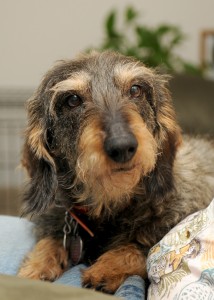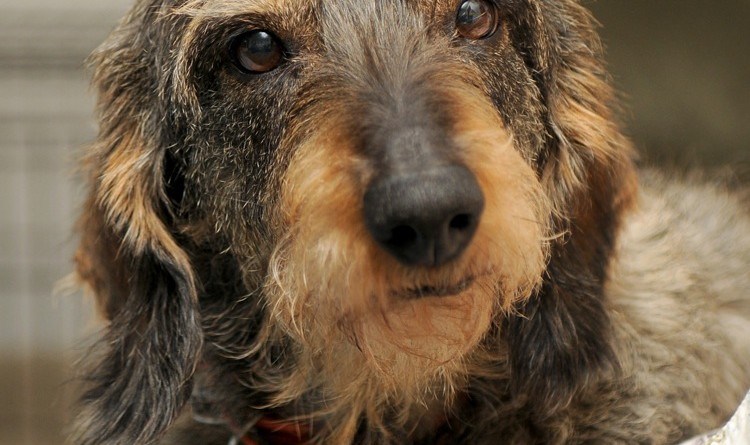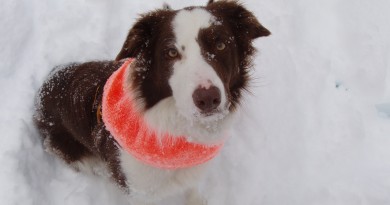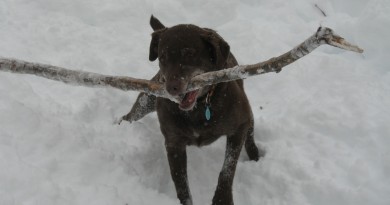Deer Tracking Dachshunds
Small Dogs a Huge Help for Hunters

Musket, an 11-year-old wirehaired dachshund, might not look like a formidable match for the forests and fields of Vermont, but the 22-pound canine has an extremely high success rate tracking wounded deer.
In New York, an organization called Deer Search has a Hall of Fame for dogs who have found more than 100 deer. If Vermont had a similar organization, Musket would qualify—he has 148 finds to his name.
Musket belongs to Chris and Tom DiPietro, two of Vermont’s licensed deer trackers. The DiPietros, of Jericho, admit that not everyone expects to see a dachshund when they call for a leashed tracking dog. “You’re going to track with that little thing?” is a common reaction. There are only 22 licensed trackers in the state, and many of them use beagles, bloodhounds, Labs and German shepherds. But the DiPietros—as well as Sally Marchmont, a tracker based in Fletcher—swear by their dachshunds, in part because the dogs make great house pets as well as tracking dogs.
A Family Affair
Tracking deer really is a family affair for the DiPietros. Tom was the first in the family to become licensed for that task. Chris followed five years later, and within a year, their son Tom Jr., known as TJ, became licensed as well. TJ’s wife, Laura DiPietro, isn’t a licensed tracker, but she’s been joining the family on outings with Avi, a 3-year-old wirehaired dachshund in tracking training.
At first blush, it might not seem like that big a deal to be following a short-legged dog in the woods, but Chris begs to differ. “The first few years I was exhausted,” she said. “You’re running behind the dogs, bouncing off trees and under things. Eventually we realized we had to train to be in shape for tracking season.” Soon Tom was running marathons and the entire family now competes in sprint triathlons.
Tom used to be an avid hunter, often going out with beagles. These days, he’s had to give up hunting since there simply isn’t time to hunt and track, but he’ll never give up bonding with his canine companions. “I’ve had a lot of dogs,” he said, “but I’ve never had a dog like Musket.”
The dachshund clan is clearly part of the household. Avi lives with TJ and Laura, but Musket, Scout, and Filou (who didn’t make the cut as a tracker) each has their own place on the couch. As Tom puts it: “There’s an incredible bond between you and your dog.”
Serious Business
For Tom, a retired IBM worker who runs his own lawn care and plowing company, tracking is serious business. He keeps meticulous records with spreadsheets showing how many deer the dogs have tracked, how long it took to find the wounded animal, if it was found, and what condition it was in. When the deer is found, photos are taken of the animal, the hunter and at least one of the trackers. Every year, Tom puts together a display board with the photos and brings it to a table that he and Chris keep at the Yankee Sportsman’s Classic. In 2010, the family went out on 53 calls and found 23 deer. Their success rate was five for nine during youth weekend. In total, Tom has gone on almost 400 tracks, and notes that Musket’s success rate would be even higher if he hand’t refused some of the calls that come in late.
Tom’s spreadsheet shows how the likelihood of finding a deer decreases dramatically the longer it takes a hunter to call. Avi and his brother Scout are still learning the ropes, but Musket is well known around the state. Tom remembers picking up a hitchhiker who asked him, “Aren’t you Musket’s father?”
“Nobody remembers our name,” quips Chris, “but they remember Musket.”
Training and the Law
Trackers are prohibited by law to charge for their work, but the DiPietros say many people offer tips or gifts of gratitude. For instance, a grandmother whose family has called a few times starts baking for the DiPietros as soon as they are called, and even made a dog-themed throw for their new couch. Often, the family refuses to take any money, but when they do, they’ll only accept enough to cover gas for their travels. On Laura’s first successful track, the hunter expressed gratitude because he would be able to feed his kids meat during the winter. Needless to say, an offer of a tip was refused.
What does it take to turn a dog into a tracker? Tom and Chris trained their dogs by first dragging a deer hide for them, and then picking the hide up and moving it. That’s followed by leaving a trail of droplets of blood, followed by an “aged” trail—waiting a half day before letting the dogs try to follow it. The dogs always get a reward for a successful track.
The couple started training Avi and Scout almost before the pups opened their eyes by leaving a blood trail toward their food dish. In addition, the dogs are acclimatized to some of the things they’ll experience in the field. When the puppies were young, they’d tag along on tracks to get adjusted to the smells in the woods. Tom took them out on four-wheelers since those are often needed to get to where the tracks start, and he even fired a gun so they wouldn’t bolt at the sound of it.
The statute allowing leashed dog trackers in Vermont is only 15 years old. Previously, the law was strict about forbidding the hunting of deer with dogs, so this carved out an exception for trackers with the provision that the dogs be on leash at all times. To help educate hunters about their service, Tom works with the state’s hunter education program. The law is very strict on what trackers can and cannot do; for instance, they must call the Vermont State Police before entering the woods and again when they leave.
By law, dogs can track bear as well as deer, but not moose. Musket has shown no interest in bear, but Petey, Sally Marchmont’s wirehaired dachshund, tracked down a bear this year.
Even if they just stick to deer, the DiPietros do their share of driving, including trips as far as Alburgh, Ferrisburgh, Hardwick, and Northfield. They wouldn’t have it any other way.
“We love to watch the dogs work,” said Chris, “and they love to do it.”
Phyl Newbeck lives in Jericho with her partner Bryan and two cats, Benji and Elway. Although neither cat is trained as a tracker, they do enjoy watching live deer on the property … from a distance. She is the author of “Virginia Hasn’t Always Been for Lovers: Interracial Marriage Bans and the Case of Richard and Mildred Loving.”



